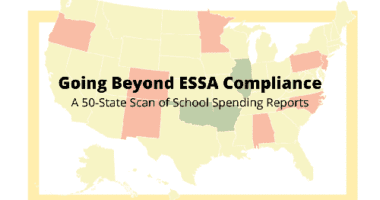What Educators and Advocates Can Learn from the 2017 NAEP Results
Every two years, the National Assessment of Education Progress (NAEP), otherwise known as the Nation’s Report Card, provides a snapshot of student achievement in fourth and eighth grade reading and math — nationally, in every state, and in a number of urban districts around the country. Here, Ed Trust shares some of our initial observations after reviewing the latest data.
Speaking as an organization that works to level the playing field for low-income students and students of color, the 2017 NAEP results are disappointing at best. Nationwide, at both the fourth and eighth grade levels, results are generally flat or declining — both for students overall and, more concerning, for low-income students and students of color. Regardless of a few bright spots within these results, states and districts around the country still need to remedy the opportunity gaps that unquestionably lead to these disparities in achievement.
Ever since the 2017 NAEP results were released on April 10, there has been public discussion about education’s “lost decade” of stagnation. This oversimplifies the work done by educators, advocates and communities across the country in recent years. While a few states and districts have nurtured significant academic improvements for historically underserved student populations, it is clear there is still much work to be done.
Results Vary Between States
Underneath national averages, there is wide variation in results between states. Some states have made substantial gains for one or more historically underserved groups of students. For example, in Idaho, scores for Latino students improved in every subject and grade. In Indiana, eighth grade math scores for Black and Latino student improved by 13 and 5 points, respectively. In Florida, fourth grade math scores for Black students improved by 5.5 points.
In other states, however, scores dropped substantially. In Washington and Arizona, fourth grade reading scores for Black students fell by more than 11 points since the 2015 assessment. In Rhode Island, scores for low-income students declined across the board, but the drop was especially steep in eighth grade math.
Results Happen Over Time
Although much of the media coverage in recent weeks has focused on changes in NAEP scores between 2015 and 2017, the latest results offer a good reminder that we also need to pay attention to trends going back a number of years. For one thing, changes in scores from one test administration to the next sometimes revert. Some of the states that made the biggest gains in fourth grade reading between 2013 and 2015, like Kentucky and Louisiana, for example, saw their scores drop back down in 2017.
Moreover, gains from one NAEP administration to the next may not even cancel out declines in prior years. For example, it’s true that national average scores in eighth grade reading improved between 2015 and 2017 both for students overall and for Latino students. Despite that improvement, however, scores for both groups are no higher than they were in 2013 — hardly a reason for celebration. Similarly, while Albuquerque’s eighth grade reading scores jumped 4 points since 2015, they are still below 2013 levels.
We should use the same caution when it comes to drops in scores. For example, despite some declines since 2015, Tennessee has still made some of the biggest gains in math for African American and low-income students in both fourth and eighth grade since 2003. Similarly, although Washington D.C.’s fourth grade reading scores stayed flat or even declined this year, the District’s gains since 2003 still make it the fastest improver on Trial Urban District Assessment (TUDA) for students overall, Black students, and Latino students.
Far more alarming are persistent drops in achievement. Take South Carolina, where following multiple years of declines, results for African American students in every tested subject and grade are lower now than they were in 2003. The failure to intervene and address such declines in student performance demonstrates a lack of leadership and should be unacceptable.
Other Factors to Consider
Further complicating things is that for the first time, students took the NAEP assessment online. Some of the declines or gains in scores may be attributed to the change in testing mode, rather than actual changes in student learning.
However, none of these caveats change NAEP’s bottom line: that as a nation, educators and advocates need to do better by our students, especially the most vulnerable. Every state and every school district needs to tackle these pervasive disparities in opportunity that are leading to the disparities in achievement — from funding and quality teaching, to access to rigorous learning experiences, including experiences with technology. Students are more than just numbers on a chart, they are children entrusted to educators to give them every opportunity they deserve. Let’s do right by them.










